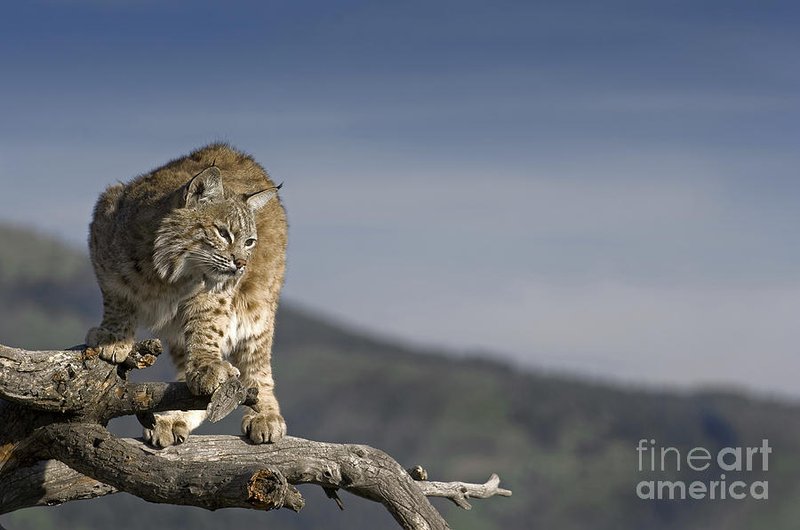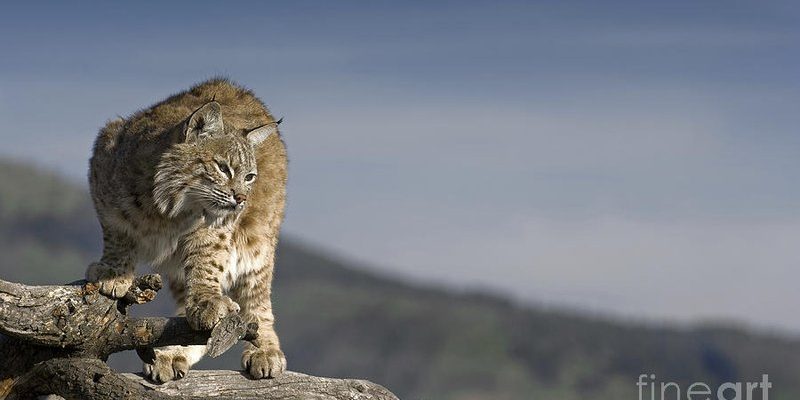
Bobcats are fascinating creatures that roam across North America. They’re not your typical house cats; these wild felines are agile, resourceful, and surprisingly adaptable. Imagine spotting one in the wild, its tawny fur blending seamlessly with the brush and trees. These animals carry a certain mystique, thanks to their elusive nature and striking appearance.
When you think of a bobcat, picture a smaller version of a lynx, sporting a short tail—hence the name “bobcat.” Their sharp, pointed ears and distinctive markings make them stand out in the wild. They often embody the spirit of the wilderness, moving stealthily through their habitats while hunting for food or simply traversing the landscape. In this article, we’ll dive deeper into the world of bobcats, exploring their behaviors, habitats, diets, and much more!
Physical Characteristics
Body Structure and Size
Bobcats are medium-sized cats, usually weighing between 15 to 30 pounds. They typically stand around 1.5 feet tall at the shoulder and can stretch up to 3.5 feet long, including their short, bobbed tails. Their fur, which ranges from reddish-brown to grayish-tan, is adorned with dark spots that serve as natural camouflage. This unique coloring helps them to blend into their surroundings and stalk their prey.
Despite their relatively small size, bobcats are built for agility and strength. Their long legs enable quick movements, perfect for pouncing on unsuspecting animals. With sharp retractable claws, they can climb trees with ease or grab hold of slippery surfaces while hunting. Their keen eyesight and acute hearing also play significant roles in their survival, allowing them to detect even the faintest noises from potential prey.
Distinctive Features
What sets bobcats apart from other wild cats is undoubtedly their short, “bobbed” tails. This feature is not just for show; it aids in maintaining balance while navigating through their often rugged habitats. Additionally, their tufted ears are a defining characteristic, adding to their striking appearance. Each ear has a small black tuft of fur on the tip, enhancing their hearing capabilities.
On closer observation, you’ll notice that bobcats have large paws and long legs, which help them travel across different terrains, whether it be snowy landscapes or rocky hills. Their whiskers are especially sensitive, helping them to navigate their surroundings, especially in low-light conditions.
Habitat and Range
Distribution Across North America
Bobcats are highly adaptable, thriving in a variety of habitats across North America, from forests and mountains to deserts and swamps. They are found from southern Canada all the way down to Mexico. This wide range is a testament to their resilience. You might find them in the dense woods of the northeastern United States or the arid landscapes of the southwestern deserts.
Interestingly, bobcats can also be found in suburban areas, where they adapt to living close to human populations. They often make their homes in dense brush, thickets, or under fallen trees, allowing them to remain hidden from both prey and potential threats. The key is their ability to blend into any environment, making them elusive and difficult to spot.
Preferred Habitats
Bobcats prefer habitats with ample cover for stalking prey, often seeking areas with dense undergrowth or mixed forests. They need access to water sources, which can range from rivers and streams to small ponds. Their hunting grounds typically include areas where small mammals, birds, and even reptiles are plentiful, allowing them to source food efficiently.
This adaptability means bobcats can thrive in various ecosystems, demonstrating their versatility and keen survival instincts. Whether in a bustling suburban neighborhood or a remote wilderness area, bobcats find ways to establish their territory and sustain themselves.
Diet and Hunting Behavior
What Do Bobcats Eat?
Bobcats are carnivorous, primarily feeding on small mammals like rabbits, hares, and rodents. They are opportunistic hunters, which means they will also take advantage of whatever prey is available, including birds and even deer when the opportunity arises. Their diet can vary significantly based on their location and the time of year, making them flexible eaters.
During colder months, when food is scarce, bobcats may expand their range or hunt larger animals to meet their dietary needs. This adaptability is crucial for their survival, especially as food sources fluctuate with changing seasons. You might be surprised to learn that bobcats can consume up to 2 pounds of food in a single meal, allowing them to go several days without eating again.
Hunting Techniques
Bobcats employ a range of hunting techniques, often relying on stealth and patience. They may use a hunting strategy known as “stalking,” where they quietly approach their prey before making a sudden dash to catch it off guard. Their sharp retractable claws help them grip onto surfaces as they move quietly through the underbrush.
These cats are also known to hunt at dusk or dawn, capitalizing on lower light levels when their prey may be less vigilant. This crepuscular behavior maximizes their chances of success. Bobcats can leap up to 10 feet in a single bound, making them formidable hunters despite their size.
Breeding and Lifespan
Reproduction and Mating Habits
Bobcats reach sexual maturity around the age of one year. Mating typically occurs in late winter, and females usually give birth to 1 to 4 kittens in the spring. The gestation period lasts about 60 to 70 days. After giving birth, the mother will care for her kittens for around 12 weeks, teaching them essential survival skills.
The kittens are born blind and rely on their mother for protection and nourishment during their early months. They gradually develop their hunting skills under her watchful eye, marking their first steps toward independence. By autumn, they’re typically ready to venture out on their own, but some may remain with their mother for a little longer before establishing their own territory.
Lifespan in the Wild and Captivity
In the wild, bobcats can live around 5 to 10 years, facing various threats such as predation, habitat loss, and human encounters. However, those in captivity can live significantly longer, often reaching up to 15 years or more due to the absence of these risks and access to veterinary care.
Understanding their lifespan helps shed light on the challenges bobcats face in the wild. Predators like coyotes or even larger hawks can pose threats to young kittens. Additionally, habitat encroachment by humans continues to put pressure on bobcat populations, prompting conservation efforts to protect their natural habitats.
Conservation Status
Threats to Bobcats
While bobcats are classified as a species of “Least Concern” by the International Union for Conservation of Nature (IUCN), they still face several threats. Habitat loss due to urban development and deforestation can significantly reduce their living spaces. Furthermore, hunting and trapping, although regulated in many areas, can impact local populations.
Automobile collisions are another growing concern as roads expand into previously untouched areas. As bobcats venture out in search of food or new territories, they may encounter dangerous traffic situations. Understanding these threats helps wildlife conservationists build better strategies for protection and management.
Conservation Efforts
Fortunately, several conservation programs aim to protect bobcats and their habitats. Many organizations work to create wildlife corridors that help bobcats navigate through urban areas safely. These corridors allow them to find food, mates, and new territories without crossing dangerous roads.
Education plays a vital role, too. Increasing awareness about bobcats and their ecological importance can help foster a sense of responsibility among local communities. By seeing bobcats as essential components of the ecosystem, we can promote healthier interactions between humans and wildlife, ensuring these marvelous creatures continue to thrive.
Interesting Facts About Bobcats
| Size: | 15 to 30 pounds |
| Height: | Approximately 1.5 feet |
| Length: | Up to 3.5 feet (including the tail) |
| Lifespan (Wild): | 5 to 10 years |
| Lifespan (Captivity): | 15 years or more |
| Diet: | Small mammals, birds, and occasionally deer |
| Adaptability: | Can thrive in various habitats |
FAQ
Are bobcats dangerous to humans?
Bobcats are generally shy creatures and prefer to avoid human contact. They pose little danger to humans unless cornered or threatened. Most interactions with bobcats are fleeting, and they usually flee when they sense human presence. However, it’s important to keep a respectful distance and not attempt to feed or approach them.
How can you identify a bobcat in the wild?
Identifying a bobcat isn’t too difficult if you know what to look for. Look for their short tail, tufted ears, and distinctive spot patterns on their fur. They are about the size of a medium dog, and their tracks often show four toes with claw imprints. Additionally, bobcats are known for their characteristic bounding gait—they often leap and land with both feet together.
Do bobcats live alone or in groups?
Bobcats are solitary animals and usually live alone, except during mating season or when a mother is raising her kittens. Each bobcat establishes its territory, which it marks with scent markings and scratches on trees. They can be quite territorial, often avoiding the territories of other bobcats.
What time of day are bobcats most active?
Bobcats are mostly crepuscular, meaning they are most active during dawn and dusk. This behavior allows them to take advantage of lower light conditions while hunting for food. While they can be seen during the day or night, these twilight hours are when they do the most foraging.
Can bobcats be kept as pets?
Keeping a bobcat as a pet is illegal in many places. Even in areas where it is permitted, bobcats are wild animals with specific needs that are difficult to meet in a domestic setting. They require vast territories, specialized diets, and opportunities to engage in natural behaviors. It’s best to admire these beautiful creatures from afar in their natural habitats.
How do bobcats communicate?
Bobcats communicate using a range of vocalizations, including growls, hisses, and screams. They also use body language, such as posturing and tail movements, to convey their mood. Scent marking is another crucial communication method—they leave their scent on trees and bushes to mark their territory and indicate their presence to other bobcats.
What are the biggest threats to bobcats?
Bobcats face several threats, including habitat loss due to urbanization, hunting, and vehicle collisions. While they are not currently endangered, these challenges can impact local populations. Conservation efforts focus on promoting habitat preservation and public education to support these beautiful creatures.
How fast can a bobcat run?
Bobcats can reach speeds of up to 30 miles per hour in short bursts. This incredible speed comes in handy when they’re stalking or chasing prey. Their agility and speed make them formidable hunters, capable of navigating through diverse terrain with ease.

